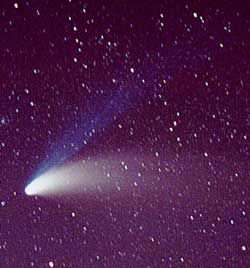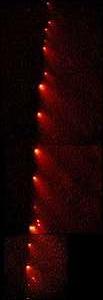_180x300.jpg) |
Origin and
Evolution
- Short period comets: Those with
periods up to a few hundred years have orbits close to
the ecliptic and come from the Kuiper belt, 30–50 AU from the
Sun, where Pluto and other distant, frozen leftover planetesimals
are located.
- Long period comets: Comets with
long periods are more icy, have randomly oriented orbits, and
come from the Oort cloud, up to 50,000–100,000 AU; Probably formed
from objects ejected in random directions by close encounters
with solar system planets, and ground up into small pieces by
collisions. There may be a trillion of them, but they
probably only make up at most a few tens of Earth masses.
- Effect of the Sun: Each passage
near the Sun makes an ice layer evaporate away (especially the
Sun-grazing ones), and radiation damage causes them to
become dark; After 500 or so passes they may fall apart
(we saw several that did in recent years).
- Other changes: Even far from
the Sun, they are affected by radiation, collisions with other objects
and sandblasting from dust grains in the interstellar medium (plus
heat
from passing
stars and supernovae...), so even "ancient" ones are
often not preserved in their original form; Some could be captured by
planets (Saturn's moon Phoebe?).
|




_180x300.jpg)
![]()